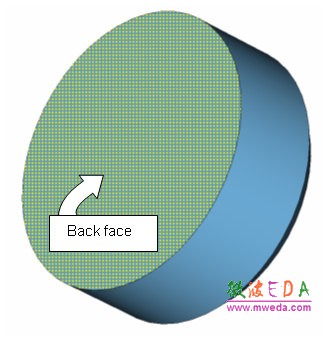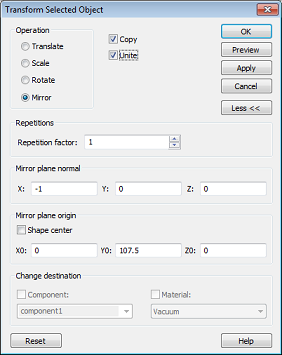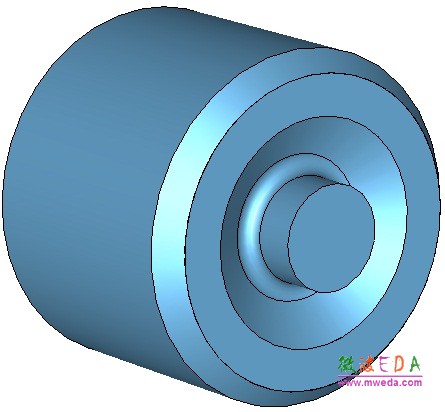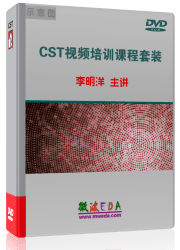- 您現(xiàn)在的位置: 微波EDA網(wǎng) >> CST >> CST設(shè)計(jì)實(shí)例 >> 正文
CST諧振腔體設(shè)計(jì)分析—CST2013設(shè)計(jì)實(shí)例
Mirror the Structure to Model the Entire Cavity
Thus far you have successfully modeled half of the cavity. The easiest way to obtain the full model is to mirror this structure at the planar back face.
The first step is to define the mirror plane by picking the corresponding face in the model. Therefore, enter the smart pick mode via Modeling: Picks > Picks .
Once the smart pick mode is active, you should double-click on the planar back face as shown in the picture above. If the face is hidden by the structure, you can use the view changing tools as explained in the Workflow and Solver Overview manual. After the face has been selected, the model should look as follows:

You should now select the cavity solid by double-clicking it. Please confirm that its name becomes highlighted in the navigation tree.
The next step is to use the transform tool to create the mirrored shape by pressing Modeling: Tools > Transform > Mirror .
In the dialog box that appears the Operation Mirror is selected. The mirror planes' coordinates will then be automatically set according to the previously-picked back face of the cavity, so you do not need to change any of the coordinate settings.

Because the transformation will create a new shape by mirroring the existing one, you have to select the Copy option. Furthermore, the original shape should also be combined with the mirrored one to form a single shape. Thus, the Unite option must also be switched on.
Finally, you should press the OK button to create the entire cavity shown below:

Solver Settings
After you have successfully modeled the cavity's geometry, you need to specify some solver settings, such as frequency range and boundary conditions, before you can finally start the solver to calculate the eigenmodes.
Define the Frequency Range
For this device, the first five resonance frequencies are estimated to be below 1.5 GHz. Open the frequency range dialog box either by pressing Simulation: Settings > Frequency . In this dialog box you should set the upper frequency limit to 1.5 (please recall that the frequency unit has been set to GHz as shown in the status bar).

Finally, press the OK button to store these settings.
-

CST中文視頻教程,資深專家講解,視頻操作演示,從基礎(chǔ)講起,循序漸進(jìn),并結(jié)合最新工程案例,幫您快速學(xué)習(xí)掌握CST的設(shè)計(jì)應(yīng)用...【詳細(xì)介紹】
- CST天線設(shè)計(jì)和天線陣設(shè)計(jì)—CST2013設(shè)計(jì)實(shí)例
CST同軸線器件的仿真設(shè)計(jì)分析—CST2013設(shè)計(jì)…
使用CST微波工作室進(jìn)行TDR計(jì)算分析
CST與Matlab連接設(shè)置
CST微波工作室和Agilent ADS 協(xié)同仿真連接設(shè)…
CST微波工作室查看VSWR結(jié)果
CST仿真分析結(jié)果如何與外部數(shù)據(jù)進(jìn)行比較
CST微波工作室采用的主要算法
使用CST微波工作室的時(shí)域求解器仿真電大問題…
電磁兼容的數(shù)值仿真分析——CST2013
CST仿真性能和仿真技術(shù)
CST設(shè)計(jì)環(huán)境 — CST2013
推薦課程
-
7套中文視頻教程,2本教材,樣樣經(jīng)典
-
國內(nèi)最權(quán)威、經(jīng)典的ADS培訓(xùn)教程套裝
-
最全面的微波射頻仿真設(shè)計(jì)培訓(xùn)合集
-
Ansoft Designer 學(xué)習(xí)培訓(xùn)課程套裝
首套Ansoft Designer中文培訓(xùn)教材
-
矢網(wǎng),頻譜儀,信號(hào)源...,樣樣精通
-
與業(yè)界連接緊密的課程,學(xué)以致用...
-
Les Besser射頻培訓(xùn)經(jīng)典原版視頻
業(yè)界大牛Les Besser的培訓(xùn)課程...
-
PCB設(shè)計(jì)學(xué)習(xí)培訓(xùn)課程套裝
Allegro,PADS,PCB設(shè)計(jì),其實(shí)很簡單..
-
Hyperlynx,SIwave,助你解決SI問題
-
現(xiàn)場講授,實(shí)時(shí)交流,工作學(xué)習(xí)兩不誤






